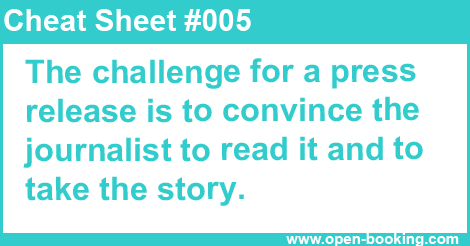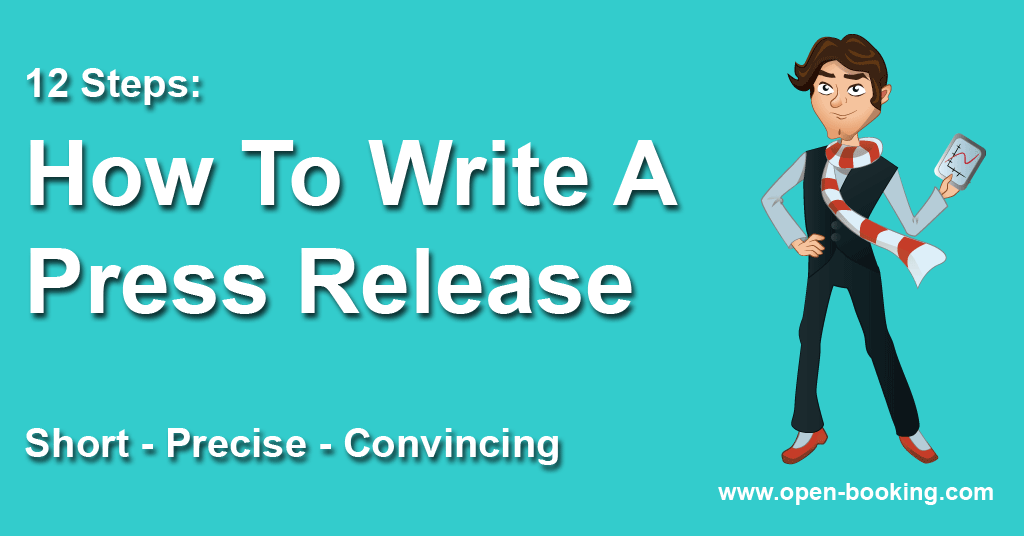Getting your business into media will help your branding. One way for awareness in local newspapers or trade press or even with bloggers is to give out press releases on your company’s news. When writing a press release you need to meet the demand of the media. There are simple rules to follow for the success of your news.
A press release should be only one page and contain the most important information. It is an art of putting the right words in the right order.
Journalists get dozens or hundreds of messages each day. The challenge for a press release is to convince a journalist to read it and to take the story. Make it easy for them.

# 1: Develop a structure
Think before write: To cluster different aspects of your story and to sort by importance will define the content of your press release. Decide about what information is most relevant. The most relevant belongs to the beginning of the text.
# 2: Your headline is essential
You know your topic well so your headline should be easy, right? Keep in mind that the headline has to attract attention of the journalist. Hold the headline short but not too short (5-7 words). Give the space to your most relevant topic. If you cannot place all in one headline, add a subhead for the missing necessary additional information or statement.
# 3: Set place and date
Several media (local newspapers) get the relevancy for mentioning yours news from the location. The location of the local reference should be clear. The date determines the actuality.
# 4: The first paragraph is the “Lead”
The lead is usually a conclusion of 3-4 sentences. It is the answer on the classical question about “Who, what, when, where, how, why?”
You’ve clustered your content already in #1 – so take the keys of your preparation for this lead. Ensure that headline and lead do not contain identical information.
# 5: Deepen information
Short paragraphs after the lead should deepen the information but do not repeat them. Bring up new aspects worth to be mentioned.
Professionals call this part of the text the “Body”.
# 6: Easy and clear wording
You are an expert on your topic – the recipient of your press release is not. For the better understanding be simple and clear so everybody understands your text at first reading.
All technical terms increase the risk that your press release will not be read. Providing clear and understandable language also means to explain technical terms, if they have to be used.
# 7: Be objective
Even if you are excited about your new product – write objectively. Avoid acquisition or selling formulations and superlatives. If your product is truly a world first, then deliver this the facts that prove this and do not get lost in enthusiasm.
# 8: Do not forget a quote!
Pimp up your press release with a matching quote. At this point your text can be subjective, because of course, your partner, manager or CEO may express your feelings about your new product.
Avoid any content in the quote. Take rather the opportunity to take a position. This also increases the chance that the journalist accepts the quote, it selects possibly as headline or primer on the topic.
# 9: Do it short
No journalist wants to read press releases that are longer than one page. Do not bore them with longer texts try even to be shorter. It is better to use few words and get a reader who wants more than to have him stopping because the text is too long.
Your topic is complex? Then there are two options. If the complex topic can be split into different topics, store some for later media releases. If you do not want to split you just tease with main aspects of the additional topics and provide further information. Keep the length of your text in mind.
# 10 Proofread by your grandma – or someone else not involved in your business
Sense of this proofread is not to find possible typos. You should be secure about the content to verify the message. Does your proof-reader understand everything right away, without having to read a sentence a second time? He stops at one point, because it lacks information? Is there an important questions unanswered?
Take the chance for fine tuning of wording in your press release before it has to pass the real gatekeeper test.
# 11 Provide a photo
No matter if a journalist will take or not – providing a photo will raise the awareness of your news. Choose one of good quality and give a line of text. Take care, that you can provide the copyrights for the use.
Consider the content of the targeted media into your selection of the photo and offer
# 12 Offer contact for research
While an actual press release usually will provide actual news, take care that a journalist can bring it into context. Provide a short company description (2-3 sentences) – it is called “Boilerplate“ – and contact for further research (“Media contact information“) like your email and phone number.
CONCLUSION
Writing press releases is no rocket science.
However, it requires a lot of discipline and the ability to bring yourself into distance from you company and product. Only then it is possible to get the essential information to the point. Only if you can convince with your topic the journalist will pick up your message and your media release will give benefit.

